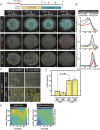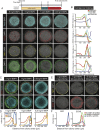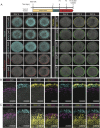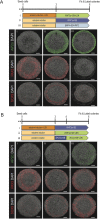A novel self-organizing embryonic stem cell system reveals signaling logic underlying the patterning of human ectoderm
- PMID: 31519692
- PMCID: PMC6826045
- DOI: 10.1242/dev.179093
A novel self-organizing embryonic stem cell system reveals signaling logic underlying the patterning of human ectoderm
Abstract
During development, the ectoderm is patterned by a combination of BMP and WNT signaling. Research in model organisms has provided substantial insight into this process; however, there are currently no systems in which to study ectodermal patterning in humans. Further, the complexity of neural plate border specification has made it difficult to transition from discovering the genes involved to deeper mechanistic understanding. Here, we develop an in vitro model of human ectodermal patterning, in which human embryonic stem cells self-organize to form robust and quantitatively reproducible patterns corresponding to the complete medial-lateral axis of the embryonic ectoderm. Using this platform, we show that the duration of endogenous WNT signaling is a crucial control parameter, and that cells sense relative levels of BMP and WNT signaling in making fate decisions. These insights allowed us to develop an improved protocol for placodal differentiation. Thus, our platform is a powerful tool for studying human ectoderm patterning and for improving directed differentiation protocols.This article has an associated 'The people behind the papers' interview.
Keywords: BMP signaling; Ectoderm development; Human embryonic stem cells; Self-organization; WNT signaling.
© 2019. Published by The Company of Biologists Ltd.
Conflict of interest statement
Competing interestsThe authors declare no competing or financial interests.
Figures







References
-
- Barry C., Schmitz M. T., Jiang P., Schwartz M. P., Duffin B. M., Swanson S., Bacher R., Bolin J. M., Elwell A. L., McIntosh B. E. et al. (2017). Species-specific developmental timing is maintained by pluripotent stem cells ex utero. Dev. Biol. 423, 101-110. 10.1016/j.ydbio.2017.02.002 - DOI - PMC - PubMed
Publication types
MeSH terms
Substances
Grants and funding
LinkOut - more resources
Full Text Sources
Other Literature Sources

